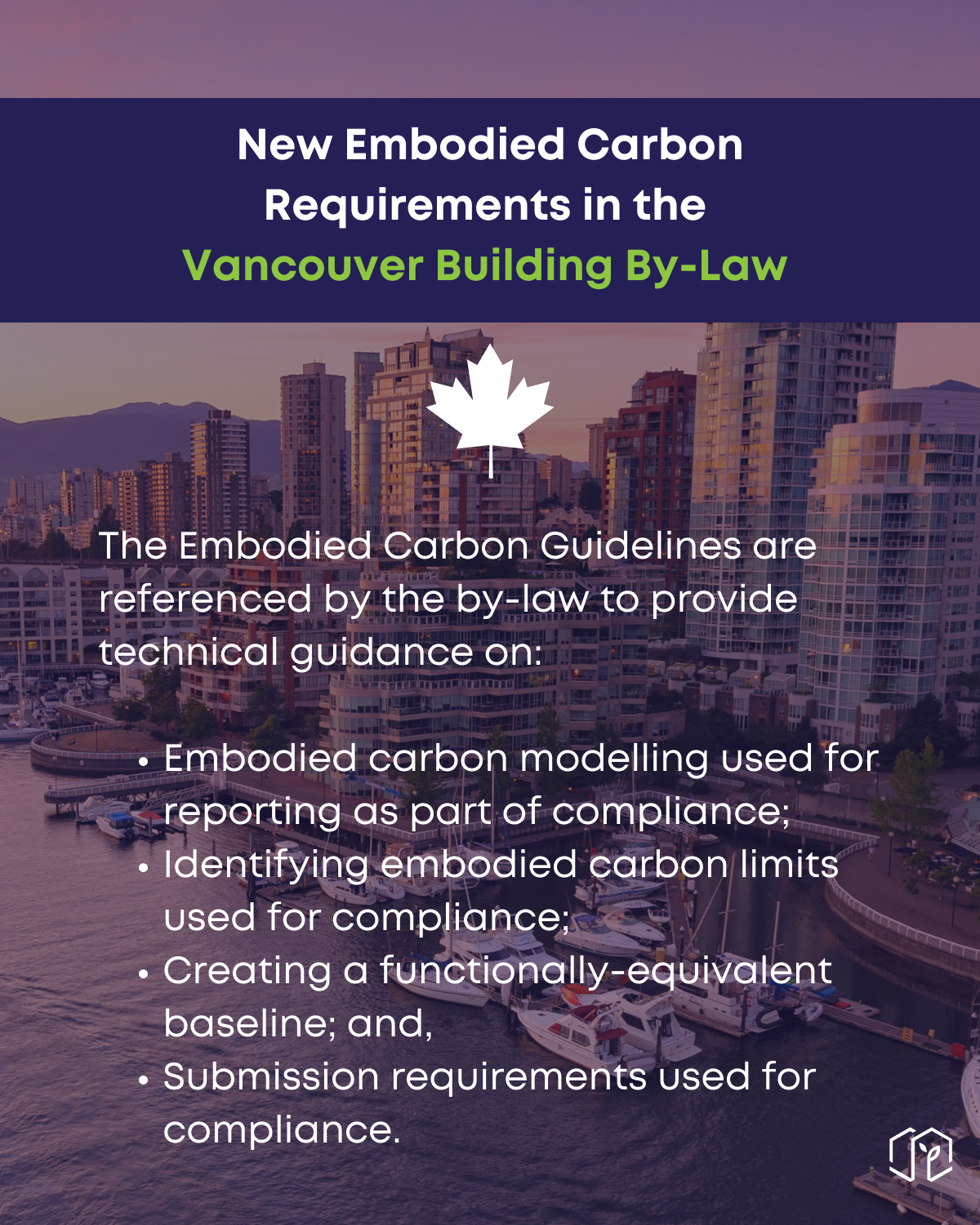Embodied Carbon in Vancouver Building By-Law
Read Time 5 mins | Written by: Alex Bantock
Vancouver's Climate Emergency Action Plan targets a 40% reduction in construction-related embodied carbon by 2030. The Vancouver Building By-law (VBBL) now mandates the assessment and reduction of embodied carbon in new constructions. The Embodied Carbon Guidelines offer technical guidance, emphasizing compliance, assessment specification, and a comprehensive approach to sustainable low embodied carbon development.
In November 2020, the City Council of Vancouver endorsed the Climate Emergency Action Plan, which aims to cut construction-related embodied carbon by 40% by 2030. Subsequently, in May 2022, modifications were made to the Vancouver Building By-law (VBBL), mandating building stakeholders to assess, restrict, and eventually diminish the embodied carbon in new Part 3 structures. Compliance with the requirements of the embodied carbon section of the by-law, and submittal of acceptable
documentation demonstrating compliance, will be required for new building permit applications received on or after October 1, 2023.
The Embodied Carbon Guidelines provide practical guidance to carbon assessment practitioners on how to comply with the City of Vancouver’s new VBBL embodied carbon requirements. The guidelines address topics like baseline definition, scope of assessment, results reporting, etc. Moreover, these guidelines can be applied to policy requirements or initiatives that mandate the reporting or reduction of embodied carbon during construction, including rezoning protocols or specific project prerequisites set by owners.
Overview of the Vancouver Building By-law (VBBL)
Before delving into the specifics of the embodied carbon guidelines, it's important to grasp the significance of the Vancouver Building By-law (VBBL). Established under the Vancouver Charter, the VBBL provides the city with the autonomy to implement by-laws that govern the design and construction of buildings. This encompasses various administrative facets, including the granting of permits, the conducting of inspections, and the meticulous enforcement of stipulated requirements.
Vancouver's unique position, courtesy of the VBBL, allows it unparalleled agility in adapting to emerging challenges. The city has consistently demonstrated its ability to be a frontrunner in setting building regulations, with a focus on:
- Safety and health standards
- Ensuring accessibility
- Modifications to existing and heritage buildings
- Regulations for Artist Live/Work Studios
- Energy consumption
- Rain screen cladding systems
- Seismic and climate-related precautions

Embodied Carbon in the VBBL
The Embodied Carbon Guidelines provide technical guidance on modelling embodied carbon and demonstrating compliance with the City of Vancouver’s requirements to report, limit, or reduce embodied carbon.
The intent of the documentation is to provide guidance on:
- Embodied carbon modelling used for reporting as part of compliance;
- Identifying embodied carbon limits used for compliance;
- Creating a functionally-equivalent baseline; and,
- Submission requirements used for compliance.
The document primarily targets organisations or individuals who are engaged in the embodied carbon modelling of buildings, facilitating their reporting and validation processes in adherence to embodied carbon regulations ("the user"). It is not designed to offer the broader building sector advice on strategies to decrease embodied carbon emissions.
Demonstrating Compliance
Calculating Embodied Carbon:
Compliance with an embodied carbon requirement is determined by following the steps:
1) Calculate the embodied carbon of the proposed design;
2) Calculate the embodied carbon benchmark using one of two pathways;
3) Calculate the embodied carbon limit by multiplying the benchmark by a reduction factor; and,
4) Compare the embodied carbon limit with the embodied carbon of the proposed design.
Note that there are two options for compliance pathways: Absolute (kgCO2e/m2) or Relative (% reduction from functionally equivalent baseline).
Quickly calculate, compare, and report of the embodied carbon of multiple design iterations
Specification of Assessment:
It is required that embodied carbon be calculated using a cradle-to-grave life cycle boundary and includes modules A1-A5, B1-B5, and C1-C4, wherever data is available.
Module D shall not be included in the embodied carbon calculations used for compliance. However, embodied carbon from module D may be calculated and reported separately.
The building elements that must be included in the embodied carbon reporting and compliance include the following:
Substructure:
- Foundations
- Subgrade Enclosures (Below-grade exterior walls)
- Slabs-on-Grade
Shell:
- Superstructure (include above and below-grade floors, above and below-grade columns and beams, above and below-grade interior shear walls, above and belowgrade stairs 4 , balconies, roof structure, and canopies).
- Exterior Vertical Enclosures (include above-grade structural and non-structural exterior walls, exterior windows and doors).
- Exterior Horizontal Enclosures (include roofing, roof windows, and skylights)
Policy Outlook
Alongside California's CALGreen Embodied Carbon amendments, this is one of the first regulations in North America to address whole-building embodied carbon emissions in the building code.
Starting this month (from the 1st of October 2023), all Part 3 buildings are required to report whole-building embodied carbon results (and not be higher than 2x the baseline) as part of the building permit submission.
Then in January 2025, it is anticipated that projects will be required to demonstrate either a 10% or 20% reduction relative to baseline, depending on building type. Additionally, projects will also have to meet one of three responsible material sourcing criteria.
References:
We'd love to hear from you!

